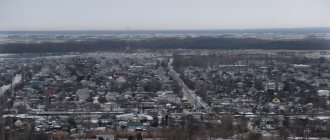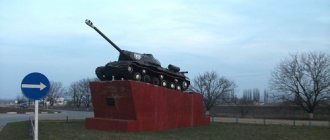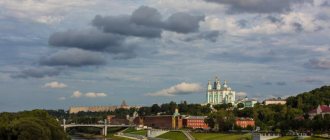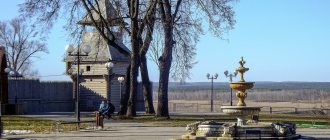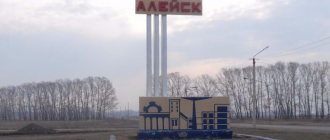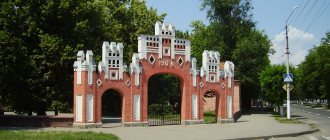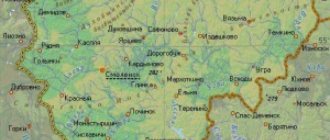Velizh
(Smolensk region)
OKATO code:
66203501
Founded:
1536
City since:
1536 City of district subordination (Velizhsky district, Smolensk region)
Center:
Velizhsky district
Telephone code (reference phone)
| 48132***** | 41-20-9 |
Deviation from Moscow time, hours:
0
Geographic latitude:
55°36′
Geographic longitude:
31°12′
Altitude above sea level, meters:
160 Sunrise and sunset times in the city of Velizh
Map
| Velizh: maps |
Velizh: photo from space (Google Maps) Velizh: photo from space (Microsoft Virtual Earth)
| Velizh. Nearest cities. Distances in km. on the map (in brackets along roads) + direction. Using the hyperlink in the distance , you can get the route (information courtesy of the AutoTransInfo website) | |||
| 1 | Usvyati (Pskov region) | 32 (37) | NW |
| 2 | Demidov | 42 (46) | SE |
| 3 | Zharkovsky (Tver region) | 72 (306) | IN |
| 4 | Rudnya | 72 (94) | YU |
| 5 | Ozerny | 76 (162) | IN |
| 6 | Kunya (Pskov region) | 78 (143) | WITH |
| 7 | Spirituality | 88 (116) | SE |
| 8 | Velikie Luki | 91 (112) | NW |
| 9 | Nevel | 91 (99) | NW |
| 10 | Western Dvina | 92 (227) | NE |
| 11 | Toropets | 103 (210) | WITH |
| 12 | Novosokolniki | 104 (146) | NW |
| 13 | Smolensk | 105 (128) | SE |
| 14 | Yartsevo | 110 (139) | SE |
| 15 | Kardymovo | 110 (156) | SE |
| 16 | White | 111 (211) | IN |
| 17 | Red | 115 (168) | YU |
| 18 | Nelidovo | 120 (259) | NE |
a brief description of
Located on the river. Western Dvina (pier), 93 km north of the railway. Rudnya station, 134 km northwest of Smolensk.
Territory (sq. km): 227
Information about the city of Velizh on the Russian Wikipedia site
Historical sketch
It was first mentioned at the end of the 14th century. At the end of the 15th - beginning of the 16th centuries. annexed to the Moscow State. The official date of foundation is 1536, when a new fortress was built on the site of an ancient settlement on the cape, at the confluence of the Konevets stream into the Western Dvina (the remains of a rampart and ditch have been preserved).
Located on the river. Western Dvina, which, according to a number of authors, in the upper reaches was once called Velya - “big”; the hypothesis is confirmed by the existence of the villages of Velishchi, Privelye, Zavelye, lying on this river.
Since 1580, under Polish rule, it received Magdeburg Law. Since 1655, as part of the Russian state, in 1678 it again went to Poland. From 1772 it was finally part of Russia.
Since 1776, the district town was first in the Pskov province, since 1777 in the Polotsk governorate, since 1796 in the Belarusian province, since 1802 in the Vitebsk province.
Until the 19th century Velizh had trade connections with Riga along the Western Dvina. The main occupations of the residents were barge construction and timber rafting.
In 1856, in the district town of Velizh, Vitebsk province, there were 10 churches, 1187 houses, 84 shops.
During the Great Patriotic War of 1941-45, it was occupied by Nazi troops on July 14, 1941. It was liberated on September 20, 1943 by troops of the Kalinin Front during the Dukhovshchina-Demidov operation. Velizh was heavily destroyed.
Economy
Velizh is an important center for timber harvesting. Lespromkhoz, forestry enterprise, furniture factory.
Flax processing plant, branch of the Moscow Electrical Mechanisms Plant, dairy plant, bakery.
In the Velizh region, grain crops, flax, and potatoes are grown. They raise cattle and pigs.
Deposits of limestone, peat, glass sand, gravel.
Museums, galleries, exhibition halls
Velizh District Museum of History and Local Lore 216290, Smolensk region, Velizh district, Velizh, sq. Dzerzhinskogo, 3/14 Phone(s): (232) 4-2464
Architecture, sights
The Velizhka River and a deep ravine with a stream divide the city into three parts. According to the general plan of 1778, Velizh received a rectangular grid of streets that took into account the historical layout. Construction according to the plan was carried out in the 19th century.
In the first half of the 19th century. the center of Velizh was built up with stone and brick houses in the style of late classicism: government offices, shopping arcades. In the second half of the 19th - early 20th centuries. buildings appeared in eclectic and modernist styles. Many religious buildings were dismantled after the war.
In accordance with the 1983 master plan, the historical left bank part of the city was preserved, and in the central part there was a park with alleys. The city is developing mainly to the north.
To the northwest of Velizh, in the village of Maklok, there is a wooden church on a brick foundation (second half of the 18th century) in a style transitioning from Baroque to Classicism.
| Population by year (thousands of inhabitants) | |||||||
| 1856 | 10.3 | 1989 | 9.1 | 2006 | 7.8 | 2015 | 7.1 |
| 1897 | 12.2 | 1992 | 9.2 | 2007 | 7.6 | 2016 | 7.1 |
| 1926 | 10.5 | 1996 | 9.3 | 2008 | 7.5 | 2017 | 7.0 |
| 1931 | 9.9 | 1998 | 9.1 | 2010 | 7.3 | 2018 | 6.8 |
| 1939 | 11.4 | 2000 | 8.8 | 2011 | 7.6 | 2019 | 6.7 |
| 1959 | 7.9 | 2001 | 8.6 | 2012 | 7.5 | 2020 | 6.6 |
| 1970 | 8.5 | 2003 | 8.3 | 2013 | 7.3 | 2021 | 6.6 |
| 1979 | 8.9 | 2005 | 8.0 | 2014 | 7.2 | ||
Unique Smolensk region: Velizh district
Unique Smolensk region
Unique Smolensk region
June 12, 2022 at 11:12 am
An ancient Russian city with architectural and historical monuments, located on the banks of the Western Dvina, traces left by a glacier, untouched, clean lakes not spoiled by human activity, swamps, full of lingonberries and other natural and historical attractions can be seen when visiting the Velizh region.
Velizh finds in the Hermitage
People settled on the banks of the Western Dvina within the borders of the modern Velizh region much earlier than writing appeared and states arose.
Since the late 60s of the 20th century, the North-Western Archaeological Expedition of the State Hermitage has been working in the Velizh region. Her work is related to the study of Stone-Iron Age monuments in the Dvina-Lovat interfluve. The excavation area is the bed of the Serteika River, which flows into the Western Dvina. As a result of underwater work, unique pile settlements were found. An international expedition also worked here, which proved the commonality of the found archaeological cultures of Western Europe and the Sertey archaeological complex.
The main exhibition telling about the life of ancient man on Velizh land can be seen in the State Hermitage Museum in St. Petersburg.
Velizh, so Velizh. As you wish...
It is still unknown where the name “Velizh” came from. There is a local legend: when, after the first partition of Poland at the end of the 18th century, Velizh finally became part of the Russian Empire, Catherine II passed through these places and the villagers who met her loyally asked the empress:
- What do you order (in the sense of order) to call this place?
The Empress apparently did not hear the question from the carriage and graciously agreed:
- Well, Velizh, so Velizh.
Since then, the city began to be called Velizh.
Of course, this is nothing more than a legend, since by the time Catherine II passed through these places, Velizh had already been hundreds of years old, confirmed in Polish-Lithuanian and Russian historically authentic documents.
But where did the name “Velizh” come from? There is no clear answer to this question.
Back at the end of the 16th century, the Polish diplomat and historian Reinhold Heidenstein wrote in his book “The Moscow War of 1578-1582” that local residents during the Livonian War, which also affected the Velizh Fortress, associated the name of the settlement with the vastness of its territory.
Another version of the origin of the city’s name is associated with the Velizhka River, which flows through the city and flows into the Western Dvina. But the opposite interpretation is also possible - the name of the river comes from the name of the city.
But the most plausible version of the origin of the name of the city is the one that says that Velizh is formed from two Slavic words: “vel” - great, big, “izh” (“hedgehog”) - means belonging to something (in this case to the Western Dvina). Thus, Velizh is a large city on the river bank. This confirms Reinhold Heidenstein's version about the origin of the city's name from the vastness of its territory.
On the border of confrontation
Velizh is one of the few cities where not only the year, but also the birthday is known. This day is considered to be July 19, 1536, when the construction of the Velizh Fortress was completed.
It would seem that by Smolensk standards Velizh is far from the most ancient city. But this “youth” is deceptive. Then, in 1536, the young Tsar Ivan Vasilyevich, later nicknamed the Terrible, together with his mother Elena Glinskaya, ordered “to build a city in the Toropetsk district on the Velizh settlement, the city of Velizh, and complete the month of July, in the third year of his state.”
Ivan IV, despite all his future formidability and, as historians note, tyranny, in this case did not just point his finger at the map and with royal grandeur said: “The city will be founded here!” The choice of location for the fortress was quite pragmatic.
The city already existed here and, being on the border of two warring Slavic states, was of strategic importance for both warring sides. It is no coincidence that two years after the fortress in Velizh was built, the ambassadors of the Polish king Sigismund, negotiating with the Russians, persistently demanded the liquidation of Velizh as a fortified point: “New towns... Zavolochye, Sebezh and Velizh and those towns would be destroyed so that they don't exist. So our ruler wants a truce with your sovereign.”
During the Livonian War of 1580, the Velizh fortress fought for a week. After being captured by the enemy, the city became part of the Polish-Lithuanian Commonwealth and received its first coat of arms and privileges.
As a border town, Velizh constantly changed hands and only in 1772, after the first partition of Poland, did it finally become part of the Russian Empire. At that time, it was listed as a city of the Polotsk governorship of the Pskov province of the Vitebsk province.
Thunderstorm of the twelfth year
After Velizh became part of Russia, it lost its status as a border city and began to live a calm, peaceful, philistine life. But this peaceful idyll did not last long, only 40 years.
With the beginning of the Patriotic War of 1812, Velizh was chosen by Russian troops as a place for storing ammunition and food, as well as for rest and treatment of the sick and wounded.
However, on June 16, 1812, the French entered Vitebsk without a fight and General Ermolov gave the order to evacuate food from Velizh to Smolensk.
Early in the morning of July 18, cavalry troops under the command of Napoleon's stepson, Viceroy of Italy Eugene Beauharnais, burst into Velizh, cutting down some of the recruits, capturing Velizh, settled in the best houses and celebrated the victory for two weeks in a row.
At the end of July, leaving their garrison in the city, French troops moved towards Smolensk. In the Velizh district, the time has come for terror and robbery.
To escape, the Velizhans fled to the north. The city and many villages were deserted.
Velizh County began to serve as a food supply and recreation center for the French.
During the general battle for Moscow, large French forces had to march past Velizh without entering the city. Russian troops under the command of the future chief of political police A.H. Benckendorf, dressed in the colors of the French army, killed the French and took Velizh, for which A.H. Benckendorf was promoted to general, and Sergei Volkonsky, the future Decembrist, to lieutenant colonel.
Velizh was finally liberated from the French on October 29, 1812. When Russian troops entered the city, they found it almost completely burned and abandoned by its inhabitants: instead of 700 houses that were here before the war, only 99 remained, and out of 5,285 Velizhans, only 595 people met their liberators.
In Velizh, the memory of fellow countrymen who distinguished themselves in the war with Napoleon is carefully preserved. In the Church of Cyril and Methodius there is a memorial plaque in memory of the Velizhanian General Pyotr Demyanovich Kakhovsky.
Sacred memory of the great war
During the Great Patriotic War, the Velizh region became the scene of fierce battles.
Just three weeks after the treacherous attack, the Germans occupied the city on July 13 after suppressing the desperate resistance of the Velizhans. During the battles in the Velizh area from July 12 to 14, 1941, the Nazis lost a large number of soldiers and equipment, including 60 tanks.
The battles for the liberation of the city began on January 28, 1942, when units of the 4th Shock Army reached Velizh, which at that time and until February 1942 was not wounded, was commanded by the future Marshal of the Soviet Union Andrei Ivanovich Eremenko.
By February 2, 1942, the small (right bank) side of the city was liberated; on the left - the enemy remained. Our troops and the enemy troops were separated by the Western Dvina.
For 18 months, until September 20, 1943, the enemy tried to push our troops back to the east, but these attempts ended in failure.
Units of the 4th Shock Army fought continuous intense battles on the occupied lines in conditions of wooded and swampy terrain, off-road conditions, snow drifts, and with an acute shortage of military equipment, ammunition, and food.
By the end of September 20, 1943, the troops of the 4th Shock Army, in a fierce battle with the enemy, which lasted three days, completely captured Velizh.
The occupation of Velizh lasted about 800 days, and the fighting for its liberation lasted continuously for 601 days. The front line was the Western Dvina River; for the liberation of Velizh and the region from the Nazis, more than 50 thousand soldiers of the 4th Shock Army died, buried in 72 graves.
Today, the residents of Velizh sacredly preserve the memory of the fallen soldiers of the 4th Shock Army, of fellow countrymen who did not return from the fronts, of injured civilians. The feat of the victims is immortalized in 37 memorial places created in their honor, 10 streets of the city are named after the heroes. In honor of the heroes of Velizhan, the Alley of Heroes of the Soviet Union was created.
A sacred place in the city is the Lidova Gora memorial, where about 10 thousand soldiers and officers are buried who gave their lives for the liberation of Velizh land. Every year on May 9 and September 20, mass events are held here with the laying of wreaths at the graves of the fallen.
Search teams annually conduct interregional “Memory Watches”. Relatives of the dead, whose names have been identified by search engines, take part in the reburials of soldiers.
Six streets in the city of Velizh are named after the commanders of the 4th Shock Army and its divisions. Veterans of the 4th Shock Army named streets after Velizh in the cities of Ivanovo, Kaliningrad, Vitebsk, Smolensk. 14 army soldiers and local historian A.G. Bordyukov was awarded the title “Honorary Citizen of the City of Velizh”.
Trail of a melted glacier
But the Velizh region is unique not only for its history and countrymen. It is also unique for its natural attractions.
Of course, the main natural attraction for Velizh is the Western Dvina. “One of the main historical rivers of the Russian land,” as the local historian, honorary citizen of Velizh A. Sapunov described it.
The Western Dvina with its flow connects three states: Russia, Belarus and Latvia. In Russia itself, it flows through the Tver and Smolensk regions. Until 1985, the entire economic life of the Velizh region was connected with the Western Dvina - wood was floated along it, cargo and passengers were transported. Currently, the river is a favorite vacation spot for residents of Velizhni: within the city there are two beaches and two beaches are available in rural settlements, in the villages of Selezni and Belyaevo.
The largest lakes of the Cheplin group - Cheplinskoye, Ryabinskoye and Gatchinskoye - are classified as natural monuments located in the Velizh region.
Located 18 kilometers southeast of Velizh near the village of Chepli, where it gets its name, Lake Cheplinskoe is considered the largest among the lakes of the Cheplin group. The length of the reservoir, stretching from north to south, is about four kilometers, and its greatest width is about seven hundred meters.
The lake is distinguished by clean, transparent water. The reservoir is inhabited by roach, perch, pike, bream, silver bream, crucian carp, chub, ide, the number of which was very significant here, tench, ruffe, rudd, bleak, burbot, pike perch. The number of crayfish has increased noticeably. Otters are found in small numbers. There are a lot of ducks on the lake, sometimes you can see a gray heron and bittern.
The other two lakes included in the Chaplinsky group are Ryabikovskoye, connected to Lake Chaplinskoye by a small channel, and Gatchinskoye, somewhat smaller than the first, but also very significant in area.
Lake Ryabikovskoe among the lakes of the Cheplin group has the lowest temperature, which indicates that here the most significant influx of groundwater compared to other lakes.
And Lake Gatchina, located on the high banks, has a particularly picturesque view.
Valuable swamps
Another unique natural complex that is notable for the Velizh region is peat bogs or, more simply, swamps - Logunovsky Moss, Matyushinsky Moss, Drozdovsky Moss and Borkovskoye.
Thus, located eleven kilometers west of Velizh, the Drozdovsky Mokh bog is well known among local residents as a cranberry bog. Migratory birds stop here, wood grouse and black storks are found here.
Piglet and Kryzhik
Unique historical and cultural attractions include two springs with healing water - within Velizh the Pyatinka spring and the Kryzhik spring located in the south of the region, one and a half kilometers from the village of Krutoye.
Only in the Velizh region on July 7 is the locally revered feast of the Holy Great Martyr Paraskeva-Friday celebrated. According to ancient legend, pious Velizh Christians saw the saint on the banks of the Western Dvina. And where she touched the ground with her feet, a source of holy healing water began to flow.
Since then, for many centuries, residents of Velizh and Pskov from all over the area have been healed by drinking pure spring water. And the source itself is called “Pyatenka”. Every year, on the tenth week after Easter, on Friday, a procession of the cross is held to the over-chapel named after St. Praskeva-Friday, which was erected on the bank of the Western Dvina near the holy spring.
The water from the Kryzhik spring is especially revered among Velizhans; they keep it at home, it does not spoil for a long time, they wash their faces with it, take it as a shrine and add it to plain water. The source is neatly arranged and is a complex of a log source and a font.
Churches of the Three Saints and Cyril and Methodius
Historically, Velizh was a multi-confessional land: at the beginning of the 20th century, 11 Orthodox churches, 1 Catholic church and 9 synagogues were active in the city alone. Unfortunately, during the Great Patriotic War, almost all of them were destroyed: of all the religious buildings, only one Orthodox Church remained - the Three Hierarchs.
It was founded in 1866 and remained operational even during the years of Soviet power and during the Great Patriotic War. Already in the post-war period, the Church of the Three Saints suffered the fate of most churches - it was first used as a cinema, then as a library, and finally as a herbicide warehouse.
The Church of the Three Saints began to be used again for its intended purpose in 1989. In 2016, the church turned 150 years old.
There is another Church of Cyril and Methodius in Velizh, built at the end of the last century with the direct support of then Metropolitan of Smolensk and Kaliningrad, and now Patriarch of All Rus' Kirill. On March 8, 2009, in the first week of Lent, the first service was held in the temple and from that moment the temple began its educational activities in the city.
On October 27, 2012, bells donated to the temple by benefactors were raised and installed on the church belfry. In the summer of 2014, the painting of the temple iconostasis was completed. On July 26, 2015, the temple iconostasis was consecrated by His Eminence Isidore, Metropolitan of Smolensk and Roslavl.
Museum antiquities
In the center of Velizh, in a building of the early 20th century, built in the Art Nouveau style with the money of the mayor of the city, merchant and local historian Onufriy Kiselyov, there is a local history museum.
The exhibition widely includes exhibits of peasant and urban life of the pre-revolutionary era and the Soviet period.
The archaeological section contains finds from the Sertey archaeological complex (late Paleolithic, Neolithic - culture of pile settlements.
The historical section is presented with materials about the entry of Velizh into the Principality of Lithuania, the Polish-Lithuanian Commonwealth, the Vitebsk province and the Smolensk region.
The military section tells about the Velizh residents - defenders of the Brest Fortress, Heroes of the Soviet Union, generals, as well as military events in Velizh and the region, the role of the 4th Shock Army of the Kalinin Front in its liberation from the Nazi invaders, as well as the partisan movement, participation of Velizhans in the military events of the Great Patriotic War.
A special place in the museum is given to famous fellow countrymen who glorified the Velizh land, including an honorary citizen of the city of Velizh, military test pilot 1st class, Doctor of Technical Sciences, retired Air Force colonel engineer, Lieutenant General of the Cossack troops, Honored Master of Sports of the USSR, Hero of the Socialist labor Marina Popovich, sculptor, professor, People's Artist of the BSSR A.O. Bembel and many other Velizhans.
Guests are always welcome in Velizh
In addition to historical and natural attractions, the interregional festival “Velizh Wave” is especially popular, and not only among residents of Velizh and the region. Traditionally, it takes place in July and is dedicated to Velizh’s birthday. As a rule, creative groups from Belarus, Pskov, Tver and Smolensk regions take part in the festival.
Traditionally, folk festivals are also held in February-March. They begin with a farewell to the Russian winter. And in April, residents and guests of the city are pleased with the annual regional festival of children's creativity and the zonal stage of the regional choreographic competition “Rhythms of the Century,” in which amateur creative groups from the Smolensk region participate.
According to tradition, on Russia Day on June 12, a festival of Russian traditional cuisine “Pancakes – Velizh. Phoebus", which is aimed at preserving and developing folklore national traditions. In the same city garden, the traditional ritual holiday of Ivan Kupala is organized in July.
To get to Velizh, guests will have to take a bus, since the railway does not pass through the city.
If you get from Moscow, then from the Belorussky station you can take any train to Smolensk, and then from the bus station of the regional center by buses Smolensk-Velizh, Smolensk-St. Petersburg, Vitebsk-Velizh.
There is a direct bus from St. Petersburg to Velizh from St. Petersburg to Smolensk.
For reference
Velizhsky district is located in the northwestern part of the Smolensk region and borders from the east and southeast with the Demidovsky district, from the south - with the Rudnyansky district, from the west - with the Vitebsk region of the Republic of Belarus, from the northwest and north - with the Pskov region, with north - with the Tver region.
The Velizh District municipality includes 8 rural settlements and 1 urban settlement. The administrative center is the city of Velizh.
The total area of the district is 1,473 square kilometers, the population is 11,045 people. Velizh itself is home to 7,068 inhabitants.
The official founding date of Velizh is July 19, 1536. In 1772, Velizh was included in the Pskov and then Polotsk provinces of the Vitebsk province, and in 1804 the city became part of the Vitebsk province.
On September 21, 1781, Catherine II granted the city a coat of arms.
In March 1918, Velizh was proclaimed part of the Belarusian People's Republic, but already in January 1919 the city was included in the RSFSR.
The Velizh district was formed in 1927, initially as part of the Leningrad region, and in 1929 it was transferred to the Western region, the center of which was Smolensk. In 1963, the district was abolished and its territory was annexed to the Demidovsky district, and was finally restored to its modern borders in 1965.
The Western Dvina River flows through the region. In 1974, a bridge was built across it in Velizh; before that, there was a ferry crossing. In the Velizh region there is the lowest point of the Smolensk region (140 meters above sea level) - where the Western Dvina crosses the border of the region and flows into Belarus.
The Olsha - Nevel highway passes through Velizh, connecting two large federal highways: M-1 (Moscow - Minsk - Western Europe) and M-20 (stretching from St. Petersburg to the south).
In Velizh, the layout of the 19th – early 20th centuries has been partially preserved, and a number of stone buildings built in the classicist style have been restored. In the district center today there are 22 architectural monuments, and on the territory of the district there are more than 30 archaeological monuments.
A sacred place for Velizhdans is the Lidova Gora memorial complex, where the ashes of more than 10 thousand soldiers who gave their lives in the defense and liberation of the city and region rest.
There are two active Orthodox churches in the city - the Three Saints and the temple-chapel of Cyril and Methodius.
Alexey GUSINSKY
